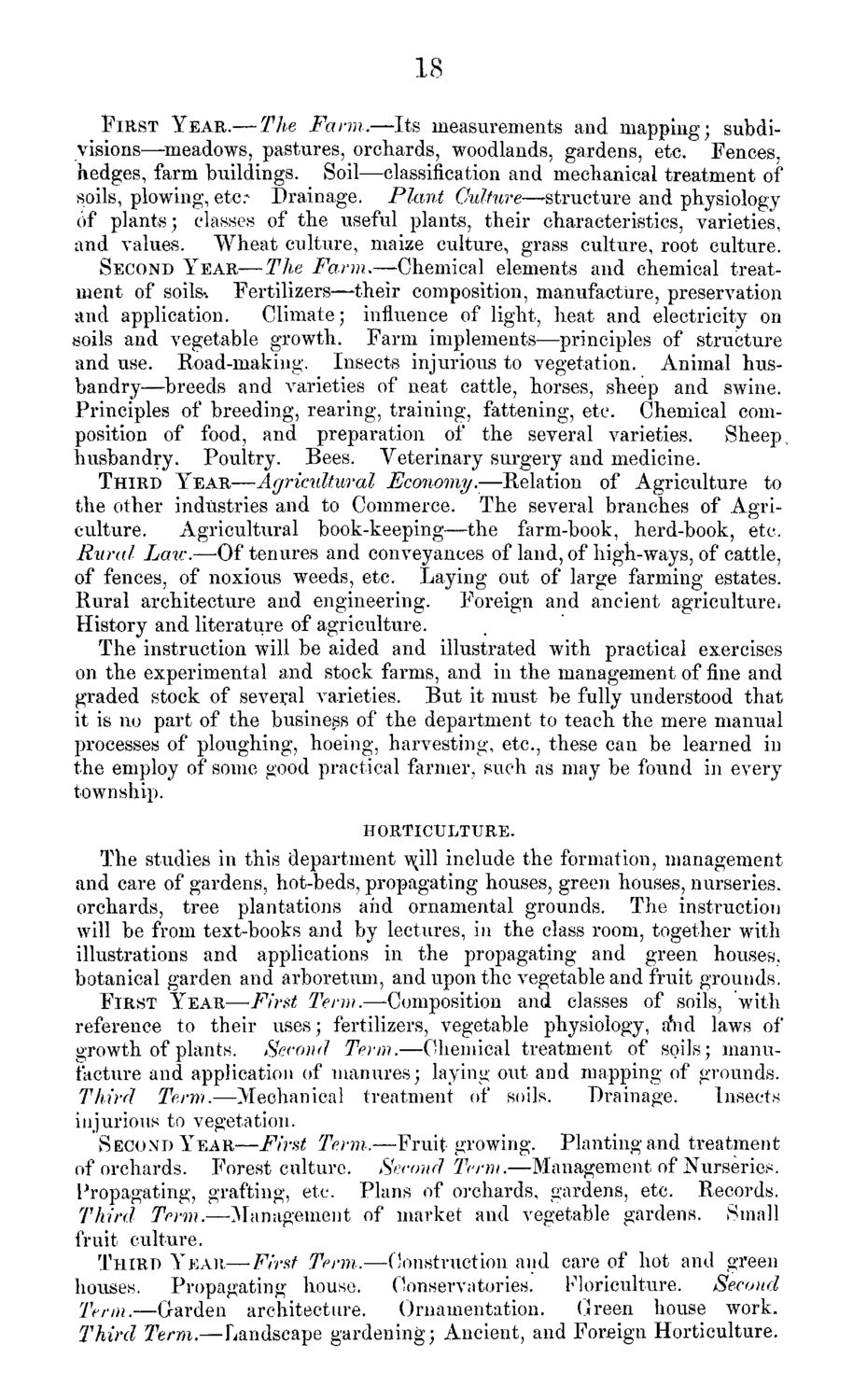| |
| |
Caption: Course Catalog - 1870-1871
This is a reduced-resolution page image for fast online browsing.

EXTRACTED TEXT FROM PAGE:
18 FIRST YEAR.— The Farm.—Its measurements and mapping; subdivisions—meadows, pastures, orchards, woodlands, gardens, etc. Fences, hedges, farm buildings. Soil—classification and mechanical treatment of soils, plowing, etc.- Drainage. Plant Culture—structure and physiology of plants; classes of the useful plants, their characteristics, varieties, and values. Wheat culture, maize culture, grass culture, root culture. SECOND YEAR—The Farm.—Chemical elements and chemical treatment of soils-. Fertilizers—their composition, manufacture, preservation and application. Climate; influence of light, heat and electricity on soils and vegetable growth. Farm implements—principles of structure and use. Road-making. Insects injurious to vegetation. Animal husbandry—breeds and varieties of neat cattle, horses, sheep and swine. Principles of breeding, rearing, training, fattening, etc. Chemical composition of food, and preparation of the several varieties. Sheep, husbandry. Poultry. Bees. Veterinary surgery and medicine. THIRD YEAR—Agricultural Economy.—Relation of Agriculture to the other industries and to Commerce. The several branches of Agriculture. Agricultural book-keeping—the farm-book, herd-book, etc. Rural Law.—Of tenures and conveyances of land, of high-ways, of cattle, of fences, of noxious weeds, etc. Laying out of large farming estates. Rural architecture and engineering. Foreign and ancient agriculture, History and literature of agriculture. The instruction will be aided and illustrated with practical exercises on the experimental and stock farms, and in the management of fine and graded stock of several varieties. But it must be fully understood that it is no part of the business of the department to teach the mere manual processes of ploughing, hoeing, harvesting, etc., these can be learned in the employ of some good practical farmer, such as may be found in every township. HORTICULTURE. The studies in this department w^ll include the formation, management and care of gardens, hot-beds, propagating houses, green houses, nurseries, orchards, tree plantations and ornamental grounds. The instruction will be from text-books and by lectures, in the class room, together with illustrations and applications in the propagating and green houses, botanical garden and arboretum, and upon the vegetable and fruit grounds. FIRST YEAR—-First Term.—Composition and classes of soils, with reference to their uses; fertilizers, vegetable physiology, aVid laws of growth of plants. Second Term.—Chemical treatment of soils; manufacture and application of manures; laying out and mapping of grounds. Third Term.—Mechanical treatment of soils. Drainage. Insects injurious to vegetation. SECOND YEAR—First Term.—Fruit growing. Planting and treatment of orchards. Forest culture. Second Term.—Management of Nurseries. Propagating, grafting, etc. Plans of orchards, gardens, etc. Records. Third Term.—Management of market and vegetable gardens. Small fruit culture. THIRD YKAR—-First Term.—Construction and care of hot and green houses. Propagating house. Conservatories. Floriculture. Second Term.—Garden architecture. Ornamentation. Green house work. Third Term.—Landscape gardening; Ancient, and Foreign Horticulture.
| |